Sviatoslav I of Kiev
Sviatoslav I Igorevich (Old East Slavic: Ст҃ославъ / Свѧтославъ[1] Игорєвичь, Svętoslavŭ Igorevičǐ; 943 – 26 March 972), also spelled Svyatoslav, was a Grand Prince of Kiev[2][3] famous for his persistent campaigns in the east and south, which precipitated the collapse of two great powers of Eastern Europe, Khazaria and the First Bulgarian Empire. He also conquered numerous East Slavic tribes, defeated the Alans and attacked the Volga Bulgars,[4][5] and at times was allied with the Pechenegs and Magyars.
| Sviatoslav the Brave | |||||
|---|---|---|---|---|---|
| Grand Prince of Kiev | |||||
Sviatoslav I by Eugene Lanceray (1886) | |||||
| Reign | 945–972 | ||||
| Coronation | 964 | ||||
| Predecessor | Saint Olga | ||||
| Successor | Yaropolk I | ||||
| Born | 943 AD Kiev | ||||
| Died | 26 March 972 AD [aged ~30] The island of Khortytsa Dnieper | ||||
| Wives |
| ||||
| Issue | With unknown woman: Yaropolk I Oleg With Malusha: Vladimir the Great | ||||
| |||||
| Dynasty | Rurik Dynasty | ||||
| Father | Igor | ||||
| Mother | Saint Olga (regent 945-964) | ||||
His decade-long reign over the Kievan Rus' was marked by rapid expansion into the Volga River valley, the Pontic steppe, and the Balkans. By the end of his short life, Sviatoslav carved out for himself the largest state in Europe, eventually moving his capital in 969 from Kiev (modern-day Ukraine) to Pereyaslavets (identified as the modern village of Nufăru, Romania)[6] on the Danube. In contrast with his mother's conversion to Christianity, Sviatoslav remained a staunch pagan all of his life. Due to his abrupt death in ambush, his conquests, for the most part, were not consolidated into a functioning empire, while his failure to establish a stable succession led to a fratricidal feud among his three sons, resulting in two of them being killed.
Name

The Primary Chronicle records Sviatoslav as the first ruler of the Kievan Rus' with a name of Slavic origin (as opposed to his predecessors, whose names had Old Norse forms). Some scholars see the name of Sviatoslav, composed of the Slavic roots for "holy" and "glory", as an artificial derivation combining the names of his predecessors Oleg and Rurik (whose names mean "holy" and "glorious" in Old Norse, respectively).[7]
Early life and personality
Virtually nothing is known about Sviatoslav's childhood and youth, which he spent reigning in Novgorod. Sviatoslav's father, Igor, was killed by the Drevlians around 945, and his mother, Olga, ruled as regent in Kiev until Sviatoslav reached maturity (ca. 963).[8] Sviatoslav was tutored by a Varangian named Asmud.[9] The tradition of employing Varangian tutors for the sons of ruling princes survived well into the 11th century. Sviatoslav appears to have had little patience for administration. His life was spent with his druzhina (roughly, "company") in permanent warfare against neighboring states. According to the Primary Chronicle, he carried on his expeditions neither wagons nor kettles, and he boiled no meat, rather cutting off small strips of horseflesh, game, or beef to eat after roasting it on the coals. Nor did he have a tent, rather spreading out a horse-blanket under him and setting his saddle under his head, and all his retinue did likewise.[10]
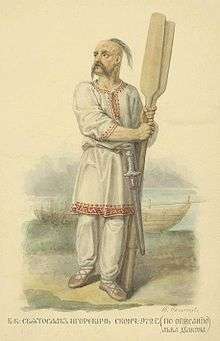
Sviatoslav's appearance has been described very clearly by Leo the Deacon, who himself attended the meeting of Sviatoslav with John I Tzimiskes. Following Deacon's memories, Sviatoslav was a bright-eyed, man of average height but of stalwart build, much more sturdy than Tzimiskes. He had bald head and a wispy beard and wore a bushy mustache and a sidelock as a sign of his nobility.[11] He preferred to dress in white, and it was noted that his garments were much cleaner than those of his men, although he had a lot in common with his warriors. He wore a single large gold earring bearing a carbuncle and two pearls.[12]
Religious beliefs
Sviatoslav's mother, Olga, converted to Orthodox Christianity at the court of Byzantine Emperor Constantine Porphyrogenitus in 957,[13] at the approximate age of 67. However, Sviatoslav remained a pagan all of his life. In the treaty of 971 between Sviatoslav and the Byzantine emperor John I Tzimiskes, the Rus' swore by the gods Perun and Veles.[14] According to the Primary Chronicle, he believed that his warriors (druzhina) would lose respect for him and mock him if he became a Christian.[15] The allegiance of his warriors was of paramount importance in his conquest of an empire that stretched from the Volga to the Danube.
Family

Very little is known of Sviatoslav's family life. It is possible that he was not the only (or the eldest) son of his parents. The Russo-Byzantine treaty of 945 mentions a certain Predslava, Volodislav's wife, as the noblest of the Rus' women after Olga. The fact that Predslava was Oleg's mother is presented by Vasily Tatishchev. He also speculated that Predslava was of a Hungarian nobility. George Vernadsky was among many historians to speculate that Volodislav was Igor's eldest son and heir who died at some point during Olga's regency. Another chronicle told that Oleg (? - 944?) was the eldest son of Igor. At the time of Igor's death, Sviatoslav was still a child, and he was raised by his mother or under her instructions. Her influence, however, did not extend to his religious observance.

Sviatoslav had several children, but the origin of his wives is not specified in the chronicle. By his wives, he had Yaropolk and Oleg.[16] By Malusha, a woman of indeterminate origins,[17] Sviatoslav had Vladimir, who would ultimately break with his father's paganism and convert Rus' to Christianity. John Skylitzes reported that Vladimir had a brother named Sfengus; whether this Sfengus was a son of Sviatoslav, a son of Malusha by a prior or subsequent husband, or an unrelated Rus' nobleman is unclear.[18]
Eastern campaigns
Shortly after his accession to the throne, Sviatoslav began campaigning to expand Rus' control over the Volga valley and the Pontic steppe region. His greatest success was the conquest of Khazaria, which for centuries had been one of the strongest states of Eastern Europe. The sources are not clear about the roots of the conflict between Khazaria and Rus', so several possibilities have been suggested. The Rus' had an interest in removing the Khazar hold on the Volga trade route because the Khazars collected duties from the goods transported by the Volga. Historians have suggested that the Byzantine Empire may have incited the Rus' against the Khazars, who fell out with the Byzantines after the persecutions of the Jews in the reign of Romanus I Lecapenus.[19]
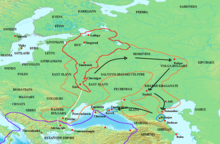
Sviatoslav began by rallying the East Slavic vassal tribes of the Khazars to his cause. Those who would not join him, such as the Vyatichs, were attacked and forced to pay tribute to the Kievan Rus' rather than to the Khazars.[20] According to a legend recorded in the Primary Chronicle, Sviatoslav sent a message to the Vyatich rulers, consisting of a single phrase: "I want to come at you!" (Old East Slavic: "хочю на вы ити")[21] This phrase is used in modern Russian (usually misquoted as "Иду на вы") and in modern Ukrainian ("Іду на ви") to denote an unequivocal declaration of one's intentions. Proceeding by the Oka and Volga rivers, he attacked Volga Bulgaria. He employed Oghuz and Pecheneg mercenaries in this campaign, perhaps to counter the superior cavalry of the Khazars and Bulgars.[22]
Sviatoslav destroyed the Khazar city of Sarkel around 965, possibly sacking (but not occupying) the Khazar city of Kerch on the Crimea as well.[23] At Sarkel he established a Rus' settlement called Belaya Vyezha ("the white tower" or "the white fortress", the East Slavic translation for "Sarkel").[24] He subsequently destroyed the Khazar capital of Atil.[25] A visitor to Atil wrote soon after Sviatoslav's campaign: "The Rus' attacked, and no grape or raisin remained, not a leaf on a branch."[26] The exact chronology of his Khazar campaign is uncertain and disputed; for example, Mikhail Artamonov and David Christian proposed that the sack of Sarkel came after the destruction of Atil.[27]
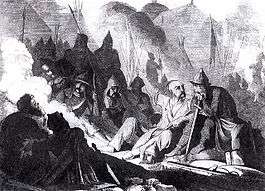
Although Ibn Haukal reports the sack of Samandar by Sviatoslav, the Rus' leader did not bother to occupy the Khazar heartlands north of the Caucasus Mountains permanently. On his way back to Kiev, Sviatoslav chose to strike against the Ossetians and force them into subservience.[28] Therefore, Khazar successor statelets continued their precarious existence in the region.[29] The destruction of Khazar imperial power paved the way for Kievan Rus' to dominate north-south trade routes through the steppe and across the Black Sea, routes that formerly had been a major source of revenue for the Khazars. Moreover, Sviatoslav's campaigns led to increased Slavic settlement in the region of the Saltovo-Mayaki culture, greatly changing the demographics and culture of the transitional area between the forest and the steppe.[30]
Campaigns in the Balkans

The annihilation of Khazaria was undertaken against the background of the Rus'-Byzantine alliance, concluded in the wake of Igor's Byzantine campaign in 944.[31] Close military ties between the Rus' and Byzantium are illustrated by the fact, reported by John Skylitzes, that a Rus' detachment accompanied Byzantine Emperor Nikephoros Phokas in his victorious naval expedition to Crete.
In 967 or 968,[32] Nikephoros sent to Sviatoslav his agent, Kalokyros, with the task of talking Sviatoslav into assisting him in a war against Bulgaria.[33] Sviatoslav was paid 15,000 pounds of gold and set sail with an army of 60,000 men, including thousands of Pecheneg mercenaries.[34][35]
Sviatoslav defeated the Bulgarian ruler Boris II[36] and proceeded to occupy the whole of northern Bulgaria. Meanwhile, the Byzantines bribed the Pechenegs to attack and besiege Kiev, where Olga stayed with Sviatoslav's son Vladimir. The siege was relieved by the druzhina of Pretich, and immediately following the Pecheneg retreat, Olga sent a reproachful letter to Sviatoslav. He promptly returned and defeated the Pechenegs, who continued to threaten Kiev.

Sviatoslav refused to turn his Balkan conquests over to the Byzantines, and the parties fell out as a result. To the chagrin of his boyars and his mother (who died within three days after learning about his decision), Sviatoslav decided to move his capital to Pereyaslavets in the mouth of the Danube due to the great potential of that location as a commercial hub. In the Primary Chronicle record for 969, Sviatoslav explains that it is to Pereyaslavets, the centre of his lands, "all the riches flow: gold, silks, wine, and various fruits from Greece, silver and horses from Hungary and Bohemia, and from Rus' furs, wax, honey, and slaves".
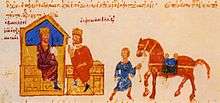
In summer 969, Sviatoslav left Rus' again, dividing his dominion into three parts, each under a nominal rule of one of his sons. At the head of an army that included Pecheneg and Magyar auxiliary troops, he invaded Bulgaria again, devastating Thrace, capturing the city of Philippopolis, and massacring its inhabitants. Nikephoros responded by repairing the defenses of Constantinople and raising new squadrons of armored cavalry. In the midst of his preparations, Nikephoros was overthrown and killed by John Tzimiskes, who thus became the new Byzantine emperor.[37]
John Tzimiskes first attempted to persuade Sviatoslav into leaving Bulgaria, but he was unsuccessful. Challenging the Byzantine authority, Sviatoslav crossed the Danube and laid siege to Adrianople, causing panic on the streets of Constantinople in summer 970.[38] Later that year, the Byzantines launched a counteroffensive. Being occupied with suppressing a revolt of Bardas Phokas in Asia Minor, John Tzimiskes sent his commander-in-chief, Bardas Skleros, who defeated the coalition of Rus', Pechenegs, Magyars, and Bulgarians in the Battle of Arcadiopolis.[39] Meanwhile, John, having quelled the revolt of Bardas Phokas, came to the Balkans with a large army and promoting himself as the liberator of Bulgaria from Sviatoslav, penetrated the impracticable mountain passes and shortly thereafter captured Marcianopolis, where the Rus' were holding a number of Bulgar princes hostage.

Sviatoslav retreated to Dorostolon, which the Byzantine armies besieged for sixty-five days. Cut off and surrounded, Sviatoslav came to terms with John and agreed to abandon the Balkans, renounce his claims to the southern Crimea, and return west of the Dnieper River. In return, the Byzantine emperor supplied the Rus' with food and safe passage home. Sviatoslav and his men set sail and landed on Berezan Island at the mouth of the Dnieper, where they made camp for the winter. Several months later, their camp was devastated by famine, so that even a horse's head could not be bought for less than a half-grivna, reports the Kievan chronicler of the Primary Chronicle.[40] While Sviatoslav's campaign brought no tangible results for the Rus', it weakened the Bulgarian statehood and left it vulnerable to the attacks of Basil the Bulgar-Slayer four decades later.
Death and aftermath
Fearing that the peace with Sviatoslav would not endure, the Byzantine emperor induced the Pecheneg khan Kurya to kill Sviatoslav before he reached Kiev. This was in line with the policy outlined by Constantine VII Porphyrogenitus in De Administrando Imperio of fomenting strife between the Rus' and the Pechenegs.[41] According to the Slavic chronicle, Sveneld attempted to warn Sviatoslav to avoid the Dnieper rapids, but the prince slighted his wise advice and was ambushed and slain by the Pechenegs when he tried to cross the cataracts near Khortitsa early in 972. The Primary Chronicle reports that his skull was made into a chalice by the Pecheneg khan.[42]
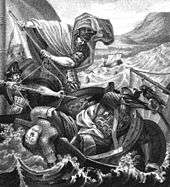
Following Sviatoslav's death, tensions between his sons grew. A war broke out between his legitimate sons, Oleg and Yaropolk, in 976, at the conclusion of which Oleg was killed. In 977 Vladimir fled Novgorod to escape Oleg's fate and went to Scandinavia, where he raised an army of Varangians and returned in 980. Yaropolk was killed, and Vladimir became the sole ruler of Kievan Rus'.
Art and literature
Sviatoslav has long been a hero of Belarusian, Russian, and Ukrainian patriots due to his great military successes. His figure first attracted attention of Russian artists and poets during the Russo-Turkish War (1768–1774), which provided obvious parallels with Sviatoslav's push towards Constantinople. Russia's southward expansion and the imperialistic ventures of Catherine II in the Balkans seemed to have been legitimized by Sviatoslav's campaigns eight centuries earlier.
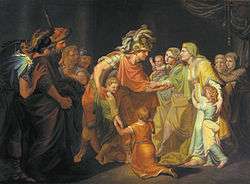
Among the works created during the war was Yakov Knyazhnin's tragedy Olga (1772). The Russian playwright chose to introduce Sviatoslav as his protagonist, although his active participation in the events following Igor's death is out of sync with the traditional chronology. Knyazhnin's rival Nikolai Nikolev (1758–1815) also wrote a play on the subject of Sviatoslav's life. Ivan Akimov's painting Sviatoslav's Return from the Danube to Kiev (1773) explores the conflict between military honour and family attachment. It is a vivid example of Poussinesque rendering of early medieval subject matter.
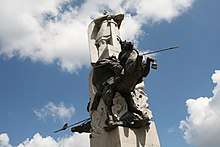
Interest in Sviatoslav's career increased in the 19th century. Klavdiy Lebedev depicted an episode of Sviatoslav's meeting with Emperor John in his well-known painting, while Eugene Lanceray sculpted an equestrian statue of Sviatoslav in the early 20th century.[43] Sviatoslav appears in the 1913 poem of Velimir Khlebnikov Written before the war (#70. Написанное до войны)[44] as an epitome of militant Slavdom:
| Знаменитый сок Дуная, | Pouring the famed juice of the Danube |
| Наливая в глубь главы, | Into the depth of my head, |
| Стану пить я, вспоминая | I shall drink and remember |
| Светлых клич: "Иду на вы!". | The cry of the bright ones: "I come at you!"[45] |
Sviatoslav is the villain of the novel The Lost Kingdom, or the Passing of the Khazars, by Samuel Gordon,[46] a fictionalised account of the destruction of Khazaria by the Rus'. The Slavic warrior figures in a more positive context in the story "Chernye Strely Vyaticha" by Vadim Viktorovich Kargalov; the story is included in his book Istoricheskie povesti.[47]
In 2005, reports circulated that a village in the Belgorod region had erected a monument to Sviatoslav's victory over the Khazars by the Russian sculptor Vyacheslav Klykov. The reports described the 13-meter tall statue as depicting a Rus' cavalryman trampling a supine Khazar bearing a Star of David and Kolovrat. This created an outcry within the Jewish community of Russia. The controversy was further exacerbated by Klykov's connections with Pamyat and other anti-Semitic organizations, as well as by his involvement in the "letter of 500", a controversial appeal to the Prosecutor General to review all Jewish organizations in Russia for extremism.[48] The Press Centre of the Belgorod Regional Administration responded by stating that a planned monument to Sviatoslav had not yet been constructed but would show "respect towards representatives of all nationalities and religions."[49] When the statue was unveiled, the shield bore a twelve-pointed star.
Sviatoslav is the main character of the books "Knyaz" ("Князь") and "The Hero" ("Герой"), written by Russian writer Alexander Mazin.
On 7 November 2011, a Ukrainian fisherman found a one metre long sword in the waters of the Dnieper on Khortytsia near where Sviatoslav is believed to have been killed in 972. The handle is made out of four different metals including gold and silver, and could possibly have belonged to Sviatoslav himself, however, there is no evidence for this assertion whatsoever and the sword could have belonged to any nobleman from that period..[50]
See also
- List of Russian rulers
- List of Ukrainian rulers
Notes
- "E.g. in the ''Primary Chronicle'' under year 970". Litopys.org.ua. Retrieved 6 July 2013.
- "Svyatoslav I - Prince of Kiev". Online Encyclopædia Britannica. Britannica.com. Retrieved 23 November 2017.
- "Vladimir I - Grand Prince of Kiev". Online Encyclopædia Britannica. Britannica.com. Retrieved 23 November 2017.
- A History of Russia: Since 1855, Walter Moss, pg 29
- Khazarian state and its role in the history of Eastern Europe and the Caucasus A.P. Novoseltsev, Moscow, Nauka, 1990. (in Russian)
- Stephenson, Paul (2000). Byzantium's Balkan Frontier: A Political Study of the Northern Balkans, 900-1204. Cambridge University Press. p. 56. ISBN 978-0-521-77017-0. Retrieved 24 November 2017.
- See А.М. Членов. К вопросу об имени Святослава, in Личные имена в прошлом, настоящем и будущем: проблемы антропонимики (Moscow, 1970).
- If Olga was indeed born in 879, as the Primary Chronicle seems to imply, she should have been about 65 at the time of Sviatoslav's birth. There are clearly some problems with chronology.
- Primary Chronicle entry for 968
- Cross and Sherbowitz-Wetzor, Primary Chronicle, p. 84.
- For the alternative translations of the same passage of the Greek original that say that Sviatoslav may have not shaven but wispy beard and not one but two sidelocks on each side of his head, see e.g. Ian Heath "The Vikings (Elite 3)", Osprey Publishing 1985; ISBN 978-0-85045-565-6, p.60 or David Nicolle "Armies of Medieval Russia 750–1250 (Men-at-Arms 333)" Osprey Publishing 1999; ISBN 978-1-85532-848-8, p.44
- Vernadsky 276–277. The sidelock is reminiscent of Turkic hairstyles and practices and was later mimicked by Cossacks.
- Based on his analysis of De Ceremoniis, Alexander Nazarenko hypothesizes that Olga hoped to orchestrate a marriage between Sviatoslav and a Byzantine princess. If her proposal was peremptorily declined (as it most certainly would have been), it is hardly surprising that Sviatoslav would look at the Byzantine Empire and her Christian culture with suspicion. Nazarenko 302.
- Froianov, I. Ia.; A. Iu. Dvornichenko; Iu. V. Krivosheev (1992). "The Introduction of Christianity in Russia and the Pagan Traditions". In Marjorie Mandelstam Balzer (ed.). Russian Traditional Culture: Religion, Gender, and Customary Law. M.E. Sharpe. p. 4. ISBN 978-1-56324-039-3. Retrieved 19 February 2017.
- Primary Chronicle _____.
- Shared maternal paternity of Yaropolk and Oleg is a matter of debate by historians.
- She is traditionally identified in Russian historiography as Dobrynya's sister; for other theories on her identity, see here.
- Indeed, Franklin and Shepard advanced the hypothesis that Sfengus was identical with Mstislav of Tmutarakan. Franklin and Shepard 200-201.
- "Rus", Encyclopaedia of Islam
- Christian 345. It is disputed whether Sviatoslav invaded the land of Vyatichs that year. The only campaign against the Vyatichs explicitly mentioned in the Primary Chronicle is dated to 966.
- Russian Primary Chronicle (ПСРЛ. — Т. 2. Ипатьевская летопись. — СПб., 1908) for year 6472. The chronicler may have wished to contrast Sviatoslav's open declaration of war to stealthy tactics employed by many other early medieval conquerors.
- For Sviatoslav's reliance on nomad cavalry, see, e.g., Franklin and Shepard 149; Christian 298; Pletneva 18.
- Christian 298. The Primary Chronicle is very succinct about the whole campaign against the Khazars, saying only that Sviatoslav "took their city and Belaya Vezha".
- The town was an important trade center located near the portage between the Volga and Don Rivers. By the early 12th century, however, it had been destroyed by the Kipchaks.
- See, generally Christian 297–298; Dunlop passim.
- Logan (1992), p. 202
- Artamonov 428; Christian 298.
- The campaign against the Ossetians is attested in the Primary Chronicle. The Novgorod First Chronicle specifies that Sviatoslav resettled the Ossetians near Kiev, but Sakharov finds this claim dubitable.
- The Mandgelis Document refers to a Khazar potentate in the Taman Peninsula around 985, long after Sviatoslav's death. Kedrenos reported that the Byzantines and Rus' collaborated in the conquest of a Khazar kingdom in the Crimea in 1016, and still later, Ibn al-Athir reported an unsuccessful attack by al-Fadl ibn Muhammad against the Khazars in the Caucasus in 1030. For more information on these and other references, see Khazars#Late references to the Khazars.
- Christian 298.
- Most historians believe the Greeks were interested in the destruction of Khazaria. Another school of thought essentializes the report of Yahya of Antioch that, prior to the Danube campaign, the Byzantines and the Rus' were at war. See Sakharov, chapter I.
- The exact date of Sviatoslav's Bulgarian campaign, which likely did not commence until the conclusion of his Khazar campaign, is unknown.
- Mikhail Tikhomirov and Vladimir Pashuto, among others, assume that the Emperor was interested primarily in diverting Sviatoslav's attention from Chersonesos, a Byzantine possession in the Crimea. Indeed, Leo the Deacon three times mentions that Sviatoslav and his father Igor controlled Cimmerian Bosporus. If so, a conflict of interests in the Crimea was inevitable. The Suzdal Chronicle, though a rather late source, also mentions Sviatoslav's war against Chersonesos. In the peace treaty of 971, Sviatoslav promised not to wage wars against either Constantinople or Chersonesos. Byzantine sources also report that Kalokyros attempted to persuade Sviatoslav to support Kalokyros in a coup against the reigning Byzantine emperor. As remuneration for his help, Sviatoslav was supposed to retain a permanent hold on Bulgaria. Modern historians, however, assign little historical importance to this story. Kendrick 157.
- All figures in this article, including the numbers of Sviatoslav's troops, are based on the reports of Byzantine sources, which may differ from those of the Slavonic chronicles. Greek sources report Khazars and "Turks" in Sviatoslav's army as well as Pechenegs. As used in such Byzantine writings as De Administrando Imperio by Constantine Porphyrogenitus, "Turks" refers to Magyars. The Rus'-Magyar alliance resulted in the Hungarian expedition against the second largest city of the empire, Thessalonica, in 968.
- W. Treadgold, A History of the Byzantine State and Society, 509
- Boris II was captured by the Byzantines in 971 and carried off to Constantinople as a prisoner.
- Kendrick 158
- Simultaneously, Otto I attacked Byzantine possessions in the south of Italy. This remarkable coincidence may be interpreted as an evidence of the anti-Byzantine German-Russian alliance. See: Manteuffel 41.
- Grekov 445–446. The Byzantine sources report the enemy casualties to be as high as 20,000, a figure modern historians find to be highly improbable.
- Franklin and Shepard 149–150
- Constantine VII pointed out that, by virtue of their controlling the Dnieper cataracts, the Pechenegs may easily attack and destroy the Rus' vessels sailing along the river.
- The use of a defeated enemy's skull as a drinking vessel is reported by numerous authors through history among various steppe peoples, such as the Scythians. Kurya likely intended this as a compliment to Sviatoslav; sources report that Kurya and his wife drank from the skull and prayed for a son as brave as the deceased Rus' warlord. Christian 344; Pletneva 19; Cross and Sherbowitz-Wetzor 90.
- E. A Lanceray. "Sviatoslav on the way to Tsargrad. Archived 7 March 2007 at the Wayback Machine ", The Russian History in the Mirror of the Fine Arts Archived 14 November 2006 at the Wayback Machine (in Russian)
- "Велимир Хлебников Творения". Lib.rus.ec. Retrieved 17 June 2012.
- Cooke, Raymond Cooke. Velimir Khlebnikov: A Critical Study. Cambridge University Press, 1987. Pages 122–123
- London: Shapiro, Vallentine, 1926
- (Moscow: Det. lit., 1989).
- "Alexander Verkhovsky. Anti-Semitism in Russia: 2005. Key Developments and New Trends". Archived from the original on 9 August 2007. Retrieved 12 November 2007.
- "The Federation of Jewish Communities protests against the presence of a Star of David in a new sculpture in Belgorod", Interfax, 21 November 2005; Kozhevnikova, Galina, "Radical nationalism and efforts to oppose it in Russia in 2005" Archived 10 January 2007 at the Wayback Machine ; "FJC Russia Appeal Clarifies Situation Over Potentially Anti-Semitic Monument" Archived 27 September 2007 at the Wayback Machine (Federation of Jewish Communities of the CIS Press Release), 23 November 2005; Dahan, David, "Jews protest trampled Star of David statue", European Jewish Press, 22 November 2005
- "On Khortitsa found the sword of Prince Svyatoslav". Rest in Ukraine. 23 September 2011. Retrieved 23 November 2017.
References
| Wikimedia Commons has media related to Sviatoslav I of Kiev. |
- Artamonov, Mikhail Istoriya Khazar. Leningrad, 1962.
- Barthold, W.. "Khazar". Encyclopaedia of Islam (Brill Online). Eds.: P. Bearman, Th. Bianquis, C. E. Bosworth, E. van Donzel and W.P. Heinrichs. Brill, 1996.
- Chertkov A. D. Opisanie voin velikago kniazya Svyatoslava Igorevicha. Moscow, 1843.
- Chlenov, A. M. (А. М. Членов.) "K Voprosu ob Imeni Sviatoslava." Lichnye Imena v proshlom, Nastoyaschem i Buduschem Antroponomiki ("К вопросу об имени Святослава." Личные имена в прошлом, настоящем и будущем: проблемы антропонимики) (Moscow, 1970).
- Christian, David. A History of Russia, Mongolia and Central Asia. Blackwell, 1999.
- Cross, S. H., and O. P. Sherbowitz-Wetzor. The Russian Primary Chronicle: Laurentian Text. Cambridge, Mass.: Medieval Academy of America, 1953.
- Dunlop, D. M. History of the Jewish Khazars. Princeton Univ. Press, 1954.
- Franklin, Simon and Jonathan Shepard. The Emergence of Rus 750-1200. London: Longman, 1996. ISBN 0-582-49091-X.
- Golden, P. B. "Rus." Encyclopaedia of Islam (Brill Online). Eds.: P. Bearman, Th. Bianquis, C. E. Bosworth, E. van Donzel and W. P. Heinrichs. Brill, 2006.
- Grekov, Boris. Kiev Rus. tr. Sdobnikov, Y., ed. Ogden, Denis. Moscow: Foreign Languages Publishing House, 1959
- Hanak, Walter K. (1995), "The Infamous Svjatoslav: Master of Duplicity in War and Peace?", in Miller, Timothy S.; Nesbitt, John (eds.), Peace and War in Byzantium: Essays in Honor of George T. Dennis, S.J., The Catholic University of America Press, ISBN 978-0-8132-0805-3, archived from the original on 17 June 2010
- Kendrick, Thomas D. A History of the Vikings. Courier Dover Publications, 2004. ISBN 0-486-43396-X
- Logan, Donald F. The Vikings in History 2nd ed. Routledge, 1992. ISBN 0-415-08396-6
- Manteuffel Th. "Les tentatives d'entrainement de la Russie de Kiev dans la sphere d'influence latin". Acta Poloniae Historica. Warsaw, t. 22, 1970. ISSN 0001-6829
- Nazarenko, A. N. (А.Н. Назаренко). Drevniaya Rus' na Mezhdunarodnykh Putiakh (Древняя Русь на международных путях). Moscow, Russian Academy of Sciences, World History Institute, 2001. ISBN 5-7859-0085-8.
- Pletneva, Svetlana. Polovtsy Moscow: Nauka, 1990. ISBN 5-02-009542-7.
- Sakharov, Andrey. The Diplomacy of Svyatoslav. Moscow: Nauka, 1982. (online)
- Subtelny, Orest. Ukraine: A History. Toronto: University of Toronto Press, 1988. ISBN 0-8020-5808-6
- Vernadsky, G. V. The Origins of Russia. Oxford: Clarendon Press, 1959.
Sviatoslav I of Kiev Rurikovich Born: 942 Died: 972 | ||
| Regnal titles | ||
|---|---|---|
| Preceded by Olga (regent) |
Prince of Kiev 960s–972 |
Succeeded by Yaropolk I Sviatoslavich |
| Titles in pretence | ||
| Preceded by Igor |
Prince of Kiev 945–960s |
Succeeded by Yaropolk I |
| Preceded by Olga |
Rulers of Kievan Rus' 945–972 |
Succeeded by Yaropolk |